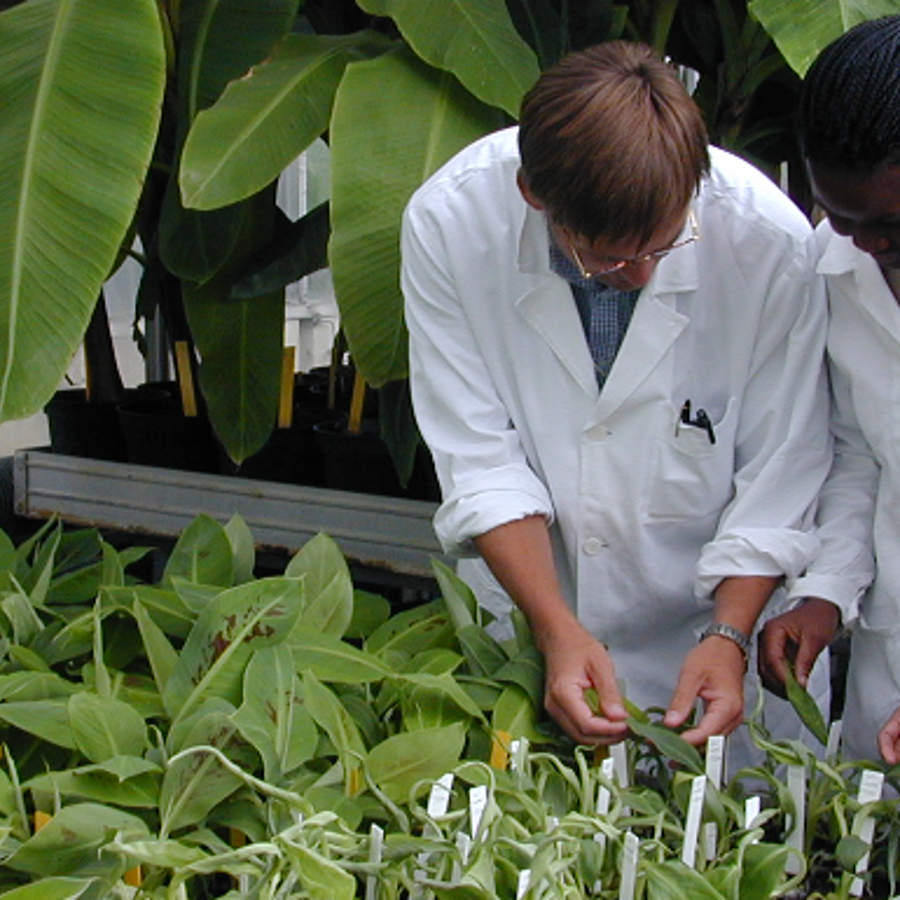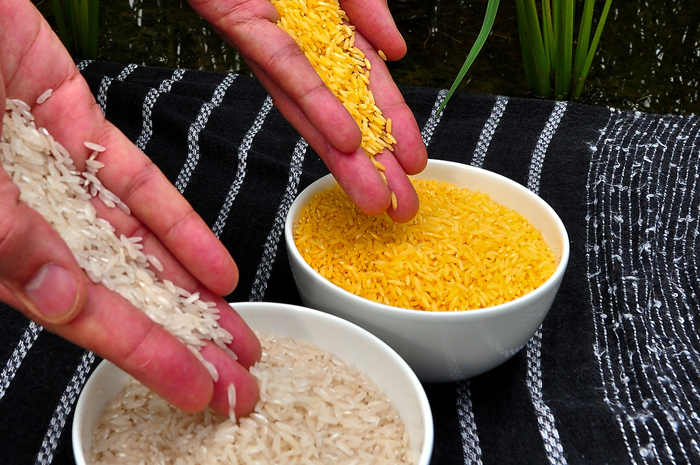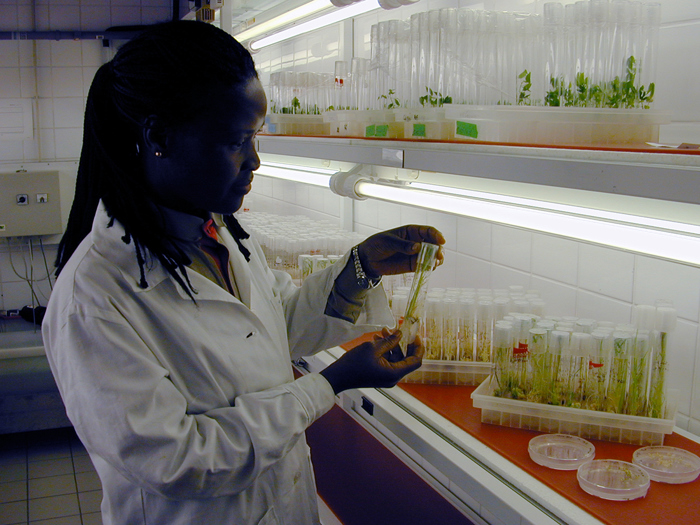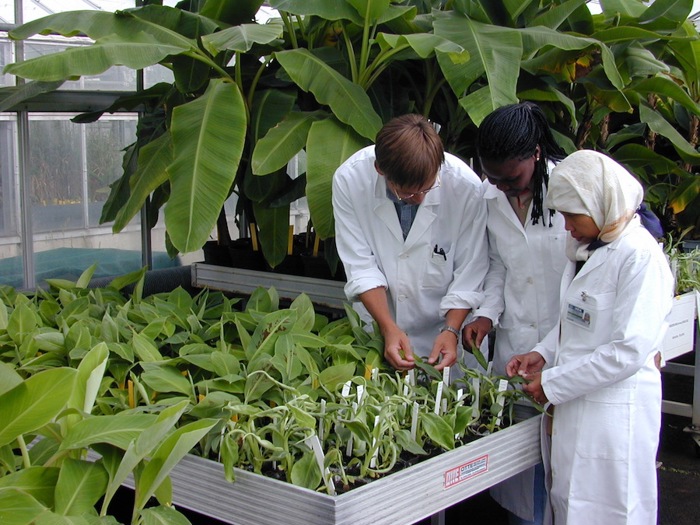
How can you modify something’s genes?
October 26, 2011

- Related Topics:
- Genetic engineering,
- GMOs,
- Mutation
An elementary school student from California asks:
"How can you modify something’s genes?"
That's a great question! There are lots of different ways of modifying something's genes. Some of them are pretty easy but most are really hard to do.
One easy way is just to blast something's genes with chemicals or radiation, which will cause random but sometimes dangerous changes. Adding in new genes is also pretty easy.
But changing a specific gene in a specific way is almost always tricky. (The exception is bacteria.) It can sometimes take years to change a specific gene in a mouse! And we can't even do these kinds of experiments in people yet.
Changing Genes Changes Traits
Scientists don't just change something's genes on a whim. They change them to try to change something about a plant or animal to try to solve a problem.
For example, if people who can only afford rice aren't getting enough nutrition, you add a gene that makes the rice more nutritious. Or if you need a plant to grow in dry, cold conditions, you change around one of the plant's genes so it can do just that. Or if you want to study a certain human disease in a mouse, you might tweak a mouse's gene.
Scientists have done all of these and more. They can add or take away genes, or change how the ones that are there already work.
Changing a gene can change a trait because each gene is really just the instructions for a specific trait. Traits can be things you see like the color of a rice grain or the shape of a leaf. Or they can be things you can't see like immunity to a disease or the nutritional value of a plant. When you change a gene you can change a trait.
What I want to do for the rest of the answer is go into more detail about some of the ways scientists go about making these changes. I'll focus on the specific examples I talked about in this section.
Adding a New Gene
Thousands of people go blind every year because they lack vitamin A in their diet. A big reason for this is that these folks eat mostly rice. And rice has no vitamin A.
One way to solve this problem is to create a kind of rice that makes vitamin A. The simplest way to do this is to add a gene for vitamin A to rice.
Remember, a gene is the recipe for a trait. And making vitamin A is a trait. So if you add a vitamin A gene, you'll add a trait.
Now making vitamin A is pretty complicated. So complicated in fact that it takes more than one gene to make it. This is why scientists had to add two genes to get rice to make β-Carotene, a precursor to vitamin A, in its kernels.
Scientists have invented lots of different ways to take genes from one plant or animal and add them to another. The most common way for plants and animals is using a virus to deliver the gene. And this is just what scientists did here.
Scientists used a virus to stick two vitamin A genes into rice to make something called golden rice. This new kind of rice makes β-Carotene, which can become vitamin A.1

Even though this sounds straightforward, it is pretty complicated. It took many years to get the new genes working well enough to make enough β-Carotene to make a difference.
Not only was it difficult, but no one has even benefited yet from this golden rice. The scientists who made it encountered people against genetically-modified organisms (GMOs) who kept the new kind of rice from getting planted.
This is why it is sometimes difficult to change something’s DNA in a way you want. Even if it works, there are many ethical and political considerations to take into account.
Randomly Changing Genes
In the mountains of Peru, it is hard for farmers to grow crops. Most plants struggle there because of drought and frost.
To help Peruvian farmers out, scientists wanted to make a plant that could deal with these conditions. They chose barley.
Instead of adding a new gene, they decided to fiddle with the genes the barley plant already had. They blasted lots of seeds with radiation and picked out the ones that could grow well in dry, cold conditions.2 To understand why this worked, we need to take a step back and talk about genes and DNA.
Genes are made up of DNA building blocks called nucleotides. Nucleotides make up an alphabet just like the alphabet we use to read and write. The DNA alphabet only has four letters: A, T, G, and C.
When we write using our alphabet, changing the order of letters can change the meaning of a word or it can change it into nonsense. For example, you can change the letters around in the word "horse" to make it into a word with a different meaning like "shore." Or you can change them around so they say "hsroe" which doesn't mean anything at all.
DNA is the same way! When a gene's letters get switched around, it can change the instructions that the gene gives. And this can sometimes give something a new, useful trait.

When the order of letters in a gene changes, we call it a mutation. Mutations can happen in nature but they don't happen very often. To speed up the process, you can zap organisms with chemicals or radiation. These damage the DNA and cause letter changes.
After you give plants or animals mutations, you want to look for the one that has the trait that you're interested in. Remember, in our example we are looking for plants that grow well even in drought and frost conditions.
If you mutate lots of plants, all you have to do is plant them and have them grow up in the harsh conditions. The plants that survive best will have had their genes modified to give them resistance to drought and frost.
When you give something chemicals or radiation, it lets you change the genes that it already has. The hard part is that most plants and animals have thousands and thousands of genes, and you can't control which genes get changed. You have to rely on chance!
Zapping something's genes can also change lots of genes at once. You might hit the right gene, but you could also hit other genes that give you traits you don't want.
But, this method does work. A lot of agricultural plants come from modifying genes in this way. Scientists have made grapefruit that stays red longer, rice that produces more grains, and pears that don't get moldy.

Other Ways to Change Genes
There are other ways to change the genes something already has that are more specific than zapping it with chemicals. Scientists have developed ways to remove a gene from something's DNA. They can also exchange one version of a gene for another.
Modifying genes in these ways can be really hard, but these changes can also teach us a lot about how genes work. They can also teach us about how diseases work so we can find cures.
Taking out a gene in a mouse or swapping it out for a new one can take years. And you often have to try many times before you can get it right.
We can't change genes around in humans yet for a lot of reasons. For example, to change genes in mice, you make certain mouse brothers and sisters have children with each other. We obviously can't do that in people! And there are lots of other technically and ethically challenging reasons too.
But one day we may work out conditions so we can change genes in people. Then we may be able to cure genetic diseases once and for all.
Read More:
- NPR: Controversy over golden rice
- The New York Times: Useful Mutants, Bred With Radiation

Author: Lisl Esherick
When this answer was published in 2011, Lisl was a Ph.D. candidate in the Department of Genetics, studying coral-algae symbiosis in John Pringle’s laboratory. She wrote this answer while participating in the Stanford at The Tech program.
 Skip Navigation
Skip Navigation
